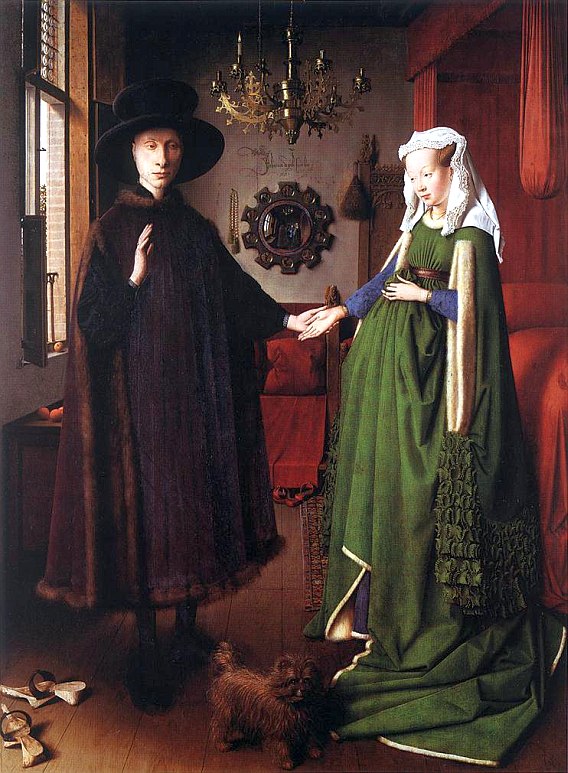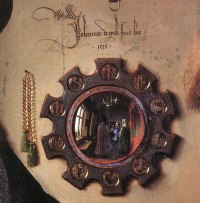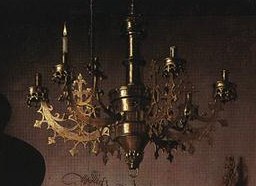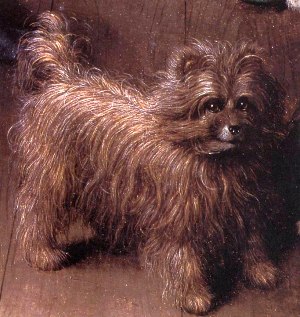 For centuries, scholars attached a bit of folklore and more than a little symbolism to the elements of this painting. Modern scholars have introduced new theories that even cast doubt on who is depicted in the painting. Regardless of what particular elements in the painting may have symbolized or even who the individuals depicted really are, this painting remains one of the most important works of the time by an innovative artist who developed many of the techniques, and even the paints, that made it possible.
For centuries, scholars attached a bit of folklore and more than a little symbolism to the elements of this painting. Modern scholars have introduced new theories that even cast doubt on who is depicted in the painting. Regardless of what particular elements in the painting may have symbolized or even who the individuals depicted really are, this painting remains one of the most important works of the time by an innovative artist who developed many of the techniques, and even the paints, that made it possible.
Portrait of Giovanni Arnolfini and his Wife was painted by the Flemish artist, Jan van Eyck (ca. 1380-1441) in 1434. He is often credited as the first artist to use oil paint on panels. It is more universally accepted that he developed new oil painting techniques which make this painting so famous and important in the world of art.
Originally, the painting was thought to serve as an almost historical record or notorized and witnessed event – the marriage of Giovanni Arnolfini, a northern Italian merchant in the Netherlands on business, and his bride Jeanne de Chenany. The details make the painting quite personal – the rosary on the wall, the fruit on the window-sill, the little brush hanging from the bedpost and the pair of shoes in the foreground. Even the cute, little scruffy dog add to the realism of the painting.
 van Eyck signed the work, not on the frame as he traditionally did, but on the back wall of the room. The inscription was in Latin “Johannes de eyck fuit hic” (Jan van Eyck was present). A close look at the mirror on the wall shows the entire setting in reverse, including two witnesses – probably van Eyck and his wife. It is believed, this painting, for the first time in history, credited the artist with being the perfect eye-witness to a major event.
van Eyck signed the work, not on the frame as he traditionally did, but on the back wall of the room. The inscription was in Latin “Johannes de eyck fuit hic” (Jan van Eyck was present). A close look at the mirror on the wall shows the entire setting in reverse, including two witnesses – probably van Eyck and his wife. It is believed, this painting, for the first time in history, credited the artist with being the perfect eye-witness to a major event.
 If you look closely, you might notice that only one candle in the chandelier is lit. Many believe that was done to symbolize the presence of God. The fact that the wooden clogs are not being worn was also thought to symbolize the holiness of the moment.
If you look closely, you might notice that only one candle in the chandelier is lit. Many believe that was done to symbolize the presence of God. The fact that the wooden clogs are not being worn was also thought to symbolize the holiness of the moment.
In this famous painting, we see Arnolfini’s bride placing her hand in his, a traditional gesture of a betrothal acceptance, particularly when a foreigner was involved.
Art scholars, according to Wikipedia, are now questioning the original intent of this painting. They believe that Jeanne de Chenany was not actually pregnant when the portrait was painted but is shown in a traditional gesture that represents virgin saints and the child-bearing potential of women. The entry further claims that recently discovered records indicate Guovanni Arnolfini’s wife died before 1434 whereby one could conclude that the women in the painting was already dead or would die during childbirth while the portrait was being completed.
 The Wikipedia article on the painting itself, Arnolfini Portrait also asserts that the painting may be of another couple entirely – perhaps a cousin.
The Wikipedia article on the painting itself, Arnolfini Portrait also asserts that the painting may be of another couple entirely – perhaps a cousin.
Personally, I prefer the folklore which has been attached to this van Eyck painting for centuries rather than some “recently discovered records.” There’s an oddly serene and troubling aspect to the painting. The man looks quite stern and the lady looks somehow demure and content. She may or may not actually be pregnant as the way she is holding her dress might be creating that illusion. She may be Jeanne de Chenany or Giovanna Cenami or Costanza Trenta. In the end, does it really matter or change the quality of the work and it’s importance in the world of art?
Regardless of where the truth might lie, this painting is one of van Eyck’s most famous and treasured works. The level of detail is truly unique for the time it was painted and the little dog would not have been possible to paint without Eyck’s improved oil paints and techniques.
To learn more about the artist and see additional examples of his work, please visit our Biography of Jan van Eyck.